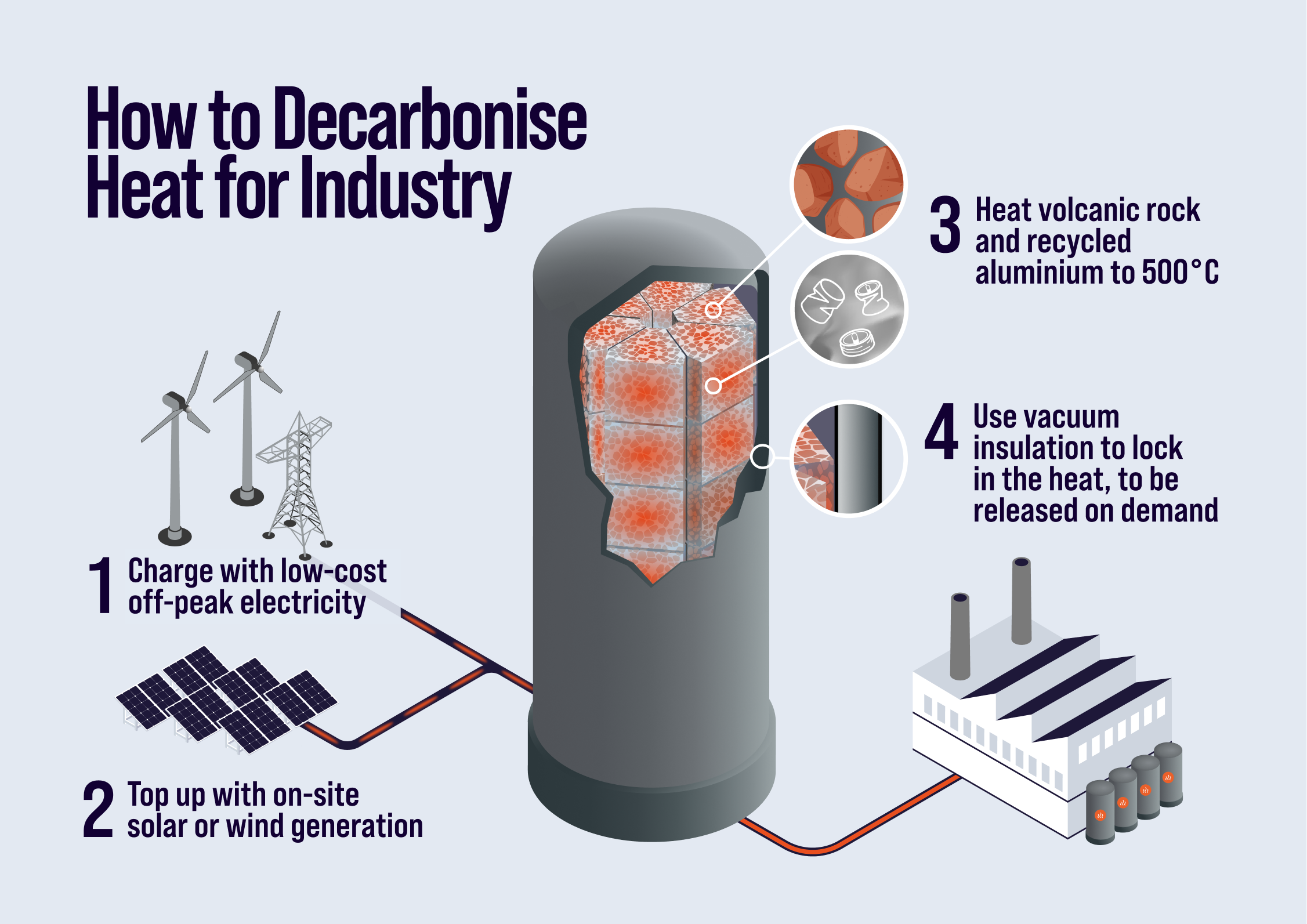Aluminium International Today article explains how Caldera's innovative Storage Boiler can help the alumina refining industry decarbonise.
With the rapid rise in electric vehicles, there is a growing glut of aluminium engine blocks – and few new users for the low-grade alloy. Now British startup Caldera has a solution – they have developed a novel way of storing green electricity as heat, using giant blocks made of recycled aluminium and volcanic rock. Their electric storage boilers will have multiple applications in industry – including delivering green heat to alumina refineries.
Follow the link above to read the full article.
James Macnaghten, co-founder and CEO of Caldera, is also interviewed by the Journal.
1. CAN YOU PROVIDE AN OVERVIEW OF YOUR COMPANY’S MISSION AND ITS APPROACH TO ELIMINATING FOSSIL FUELS THROUGH ENERGY STORAGE?
Caldera’s mission is to eliminate the use of fossil fuels in industry by storing renewable energy as heat, ready to be used when required. Around 70 percent of industrial fuel demand in Britain is for heat – and around 30 percent of this is for industrial steam in the range 100-200 C – for use in processes such as pharmaceuticals, food manufacturing and brewing. Typically, this is provided by steam boilers that burn gas or oil. In contrast, we have developed a novel type of storage boiler which takes cheap, green off-peak electricity and stores it in heat cells made of low-grade scrap aluminium and rock – ready to be released as hot water or steam when required.
2. RENEWABLE ENERGY SOURCES OFTEN HAVE INTERMITTENT AVAILABILITY. HOW DOES YOUR COMPANY ADDRESS THE CHALLENGE OF STORING AND EFFICIENTLY UTILISING THIS ENERGY WHEN NEEDED?
We believe heat storage is the key! One of the challenges with renewables is that the sun does not always shine and the wind does not always blow. Rather than storing this energy as electricity in batteries, which then has to be converted into heat, we have developed a means to store this renewable energy efficiently directly as heat, ready to be used when required.
3. HOW DOES IT WORK?
Our ground-breaking electric boiler comprises multiple heat cells, each filled with a special aluminium-rock composite. Each heat cell houses a solid core of aluminium-rock composite encased in vacuum insulation which can store heat at temperatures from 200 to 500C and can retain this heat at high efficiency for many hours.

Each system can be set to charge either from on-site renewables, such as solar, or from the grid when cheaper and greener electricity is available. These modular cells can store this electricity with very high efficiency for hours, ready to deliver heat on demand at temperatures between 80 to 200C – the sweet spot for many industrial processes. Alumina production requires higher temperature steam and, as James Macnaghten explains, ‘we can easily adjust the system to supply 300C steam with only a small reduction in thermal storage capacity per tonne of material.
4. HOW IMPORTANT IS ALUMINIUM IN YOUR PRODUCTS/PROCESSES AND WHAT ROLE DOES IT PLAY?
Aluminium is a vital component of our technology. It can be combined with volcanic rock, such as basalt, to create our aluminium-rock composite, which can be thought of as super conductive, ultra-tough concrete. It can deliver heat 50 times more quickly than concrete, yet unlike concrete it does not crack when thermally stressed. Crucially, the quality of the aluminium is not important, and therefore we can become a key user of low-grade, recycled aluminium, such as old engine blocks, which will become increasingly available with the demise of internal combustion engines.
5. WHERE HAVE YOU REACHED IN THE DEVELOPMENT OF YOUR TECHNOLOGY?
In June Caldera was awarded £4.3 million from the Department for Energy Security & Net Zero to build a full-scale demonstrator at our Southampton site, where we will showcase the technology to potential customers. This will be operational later this year. The system can store 4MWh’s of heat and charges at 1MW.
We have already signed an Memorandum of Understanding (MoU) with a major NHS Trust to pilot the use of our heat storage system, and we have also engaged the Manufacturing Technology Centre to design a ‘gigafactory’ where we can start to manufacture and roll out hundred and ultimately thousands of heat storage systems in the years ahead.
6. ENERGY STORAGE CAN BE CAPITAL-INTENSIVE. CAN YOU DISCUSS THE INVESTMENT STRATEGIES AND FINANCIAL MODELS YOUR COMPANY USES TO FUND ITS PROJECTS AIMED AT ELIMINATING FOSSIL FUELS?
Because our technology uses low-cost materials, our storage is around a third of the cost of batteries. And our input energy is cheap. On-site solar power is now incredibly cheap and getting cheaper, and our heat batteries can soak up all of a nearby solar farm’s output, without putting any pressure on the electricity grid. In addition, we can take advantage of off-peak electricity by importing electricity from the grid when it is abundant and prices are low. Together, this gives industrial users a cost-effective route to decarbonise some or all of their heat demand.

